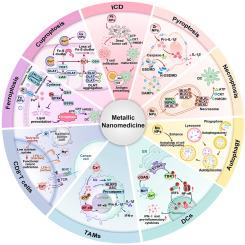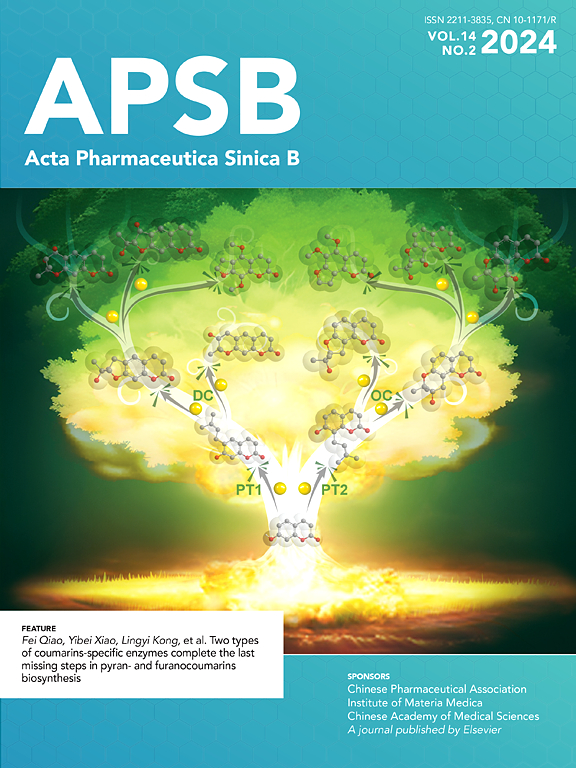Metallic nanomedicine in cancer immunotherapy
IF 14.6
1区 医学
Q1 PHARMACOLOGY & PHARMACY
引用次数: 0
Abstract
Immunotherapy has become a pivotal modality in clinical cancer treatment. However, its effectiveness is limited to a small subset of patients due to the low antigenicity, impaired innate response, and various adaptive immune resistance mechanisms of the tumor microenvironment (TME). Accumulating evidence reveals the critical roles of metal elements in shaping immunity against tumor progression and metastasis. The marriage of metalloimmunotherapy and nanotechnology further presents new opportunities to optimize the physicochemical and pharmacokinetic properties of metal ions in a precise spatiotemporal control manner. Several metallodrugs have demonstrated encouraging immunotherapeutic potential in preliminary studies and are currently undergoing clinical trials at different stages, yet challenges persist in scaling up production and addressing long-term biosafety concerns. This review delineates how metal materials modulate biological activities across diverse cell types to orchestrate antitumor immunity. Moreover, it summarizes recent progress in smart drug delivery-release systems integrating metal elements, either as cargo or vehicles, to enhance antitumor immune responses. Finally, the review introduces current clinical applications of nanomedicines in metalloimmunotherapy and discusses potential challenges that impede its widespread translation into clinical practice.

金属纳米药物在癌症免疫治疗中的应用
免疫治疗已成为临床肿瘤治疗的关键方式。然而,由于其抗原性低、先天反应受损以及肿瘤微环境(TME)的各种适应性免疫抵抗机制,其有效性仅限于一小部分患者。越来越多的证据揭示了金属元素在形成免疫系统以抵抗肿瘤进展和转移中的关键作用。金属免疫疗法和纳米技术的结合进一步为优化金属离子的物理化学和药代动力学特性提供了新的机会,以精确的时空控制方式。一些金属药物在初步研究中显示出令人鼓舞的免疫治疗潜力,目前正在进行不同阶段的临床试验,但在扩大生产和解决长期生物安全问题方面仍然存在挑战。本文综述了金属材料如何调节不同细胞类型的生物活性以协调抗肿瘤免疫。此外,它还总结了集成金属元素的智能药物释放系统的最新进展,无论是作为货物还是车辆,以增强抗肿瘤免疫反应。最后,本文介绍了纳米药物在金属免疫治疗中的临床应用,并讨论了阻碍其广泛转化为临床实践的潜在挑战。
本文章由计算机程序翻译,如有差异,请以英文原文为准。
求助全文
约1分钟内获得全文
求助全文
来源期刊

Acta Pharmaceutica Sinica. B
Pharmacology, Toxicology and Pharmaceutics-General Pharmacology, Toxicology and Pharmaceutics
CiteScore
22.40
自引率
5.50%
发文量
1051
审稿时长
19 weeks
期刊介绍:
The Journal of the Institute of Materia Medica, Chinese Academy of Medical Sciences, and the Chinese Pharmaceutical Association oversees the peer review process for Acta Pharmaceutica Sinica. B (APSB).
Published monthly in English, APSB is dedicated to disseminating significant original research articles, rapid communications, and high-quality reviews that highlight recent advances across various pharmaceutical sciences domains. These encompass pharmacology, pharmaceutics, medicinal chemistry, natural products, pharmacognosy, pharmaceutical analysis, and pharmacokinetics.
A part of the Acta Pharmaceutica Sinica series, established in 1953 and indexed in prominent databases like Chemical Abstracts, Index Medicus, SciFinder Scholar, Biological Abstracts, International Pharmaceutical Abstracts, Cambridge Scientific Abstracts, and Current Bibliography on Science and Technology, APSB is sponsored by the Institute of Materia Medica, Chinese Academy of Medical Sciences, and the Chinese Pharmaceutical Association. Its production and hosting are facilitated by Elsevier B.V. This collaborative effort ensures APSB's commitment to delivering valuable contributions to the pharmaceutical sciences community.
 求助内容:
求助内容: 应助结果提醒方式:
应助结果提醒方式:


